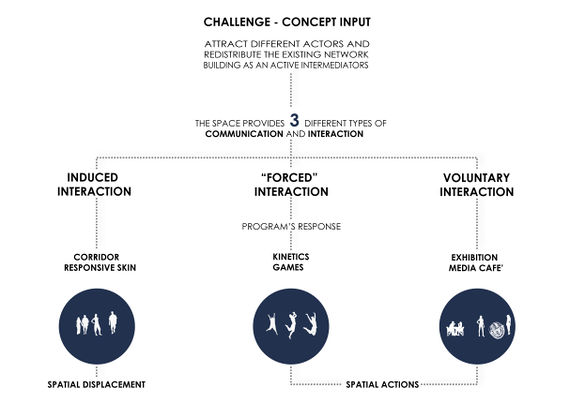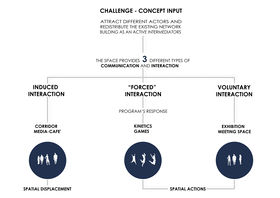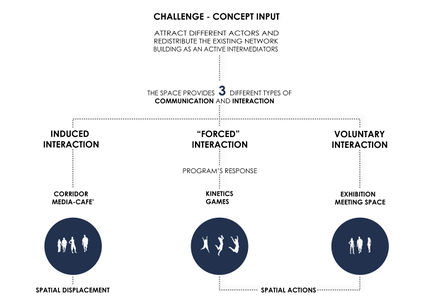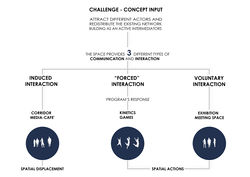project F:Design-a
Design Realisation Relationships
Intervention Design illustration Scenarios
INTERVENTION
The pavilion is a living object, put on the paths of the people moving at the campus site. The pavilion captures the movement and intertwines the paths of passers by, who then become an essential part of the interactive experience.The pavilion expresses the movement in breathing that a passerby can feel with many senses. The breathing is actuated by the movement inside the airy hallway. The air flowing in the pipes and the movement of the cushions is an audible message of people passing by.
As the cushions shrink and enlarge, the patterns on the transparent surface will project a constantly changing pattern on the ground. Sometimes the patterns align and expose more of the exterior, but when inactive, the view of the surroundings is more closed.
The activity inside the pavilion is visible from outside as well, as the series of cushion panels compress and inflate according to the moving people.
The patterns on the surface change when the layers change their relation, and the illusion of movement can be seen even when the structure is stable. When approaching the structure, the patterns cause a visual illusion of movement. In the evening the more invert function turns upside down and projects the ever changing patterns on the surroundings, exposing the flow of people.
The pavilion is a living object, put on the paths of the people moving at the campus site. The pavilion captures the movement and intertwines the paths of passers by, who then become an essential part of the interactive experience.
The pavilion expresses the movement in breathing that a passerby can feel with many senses. The breathing is actuated by the movement inside the airy hallway. The air flowing in the pipes and the movement of the cushions is an audible message of people passing by.
INTERVENTION
The pavilion is a living object, put on the paths of the people moving at the campus site. The pavilion captures the movement and intertwines the paths of passers by, who then become an essential part of the interactive experience.The pavilion expresses the movement in breathing that a passerby can feel with many senses. The breathing is actuated by the movement inside the airy hallway. The air flowing in the pipes and the movement of the cushions is an audible message of people passing by.
As the cushions shrink and enlarge, the patterns on the transparent surface will project a constantly changing pattern on the ground. Sometimes the patterns align and expose more of the exterior, but when inactive, the view of the surroundings is more closed.
The activity inside the pavilion is visible from outside as well, as the series of cushion panels compress and inflate according to the moving people.
The patterns on the surface change when the layers change their relation, and the illusion of movement can be seen even when the structure is stable. When approaching the structure, the patterns cause a visual illusion of movement. In the evening the more invert function turns upside down and projects the ever changing patterns on the surroundings, exposing the flow of people.
The pavilion expresses the movement in breathing that a passerby can feel with many senses. The breathing is actuated by the movement inside the airy hallway. The air flowing in the pipes and the movement of the cushions is an audible message of people passing by.
As the cushions shrink and enlarge, the patterns on the transparent surface will project a constantly changing pattern on the ground. Sometimes the patterns align and expose more of the exterior, but when inactive, the view of the surroundings is more closed.
The activity inside the pavilion is visible from outside as well, as the series of cushion panels compress and inflate according to the moving people.
The patterns on the surface change when the layers change their relation, and the illusion of movement can be seen even when the structure is stable. When approaching the structure, the patterns cause a visual illusion of movement. In the evening the more invert function turns upside down and projects the ever changing patterns on the surroundings, exposing the flow of people.
INTERVENTION
The patterns on the surface change when the layers change their relation, and the illusion of movement can be seen even when the structure is stable. When approaching the structure, the patterns cause a visual illusion of movement. In the evening the more invert function turns upside down and projects the ever changing patterns on the surroundings, exposing the flow of people.





